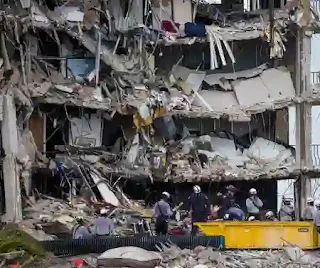Specialists doing combating time, climate and fire to accumulate DNA to distinguish Surfside townhouse breakdown casualties
Specialists doing combating time, climate and fire to accumulate DNA to distinguish Surfside townhouse breakdown casualties
USA 29/06/2021Crisis groups at the site of an imploded South Florida apartment suite aren't simply doing combating summer climate, seething fire and risky garbage in their competition to discover 149 unaccounted-for casualties. They're battling time, warmth, water and different components that will make it harder to distinguish the dead.
The more drawn out the pursuit takes, the more probable it is that human remaining parts will have decayed essentially, making DNA distinguishing proof really testing, specialists say.
On Tuesday, searchers finished the 6th day of meticulous work since the breakdown. Authorities say they think of it as a salvage mission, not a recuperation. Notwithstanding, nobody has been found alive since Thursday in the midst of the heaps of broken and pummeled concrete, bent metal, and hanging trash.
Considering the conditions at the site and the time that is passed, "this truly comes down to DNA investigation," said Victor Weedn, Maryland's central clinical analyst and a DNA master on the staff of George Washington University's Department of Forensic Sciences.
Who were the victims?
Recollecting the individuals who kicked the bucket in the apartment suite building breakdown in Surfside
Criminological science specialists say DNA ID will require weeks, if not longer. In any case, it presumably will not take as long as past mass setback occasions. That is mostly a direct result of advances in innovation prodded by the 9/11 fear based oppressor assault that obliterated the World Trade Center – and provoked a casualty ID exertion that proceeds with today.
"It's anything but a productive 20 years as far as DNA innovation propels," said Tracey Dawson Green, an educator and seat of Virginia Commonwealth University's Department of Forensic Science. "Presently, only a couple cells of DNA are sufficient to do an ID."
The challenge of identifying victims at collapsed condo
It's hard to recognize casualties in a mass-loss occasion like the breakdown of the Champlain Towers South Condominium in Surfside, Florida.
Agents first search for dress that relatives would perceive. They additionally check for IDs in casualties' pockets or totes.
Be that as it may, most occupants were sleeping when the 12-story building imploded early Thursday morning. They might not have been wearing effectively recognizable dress and might not have had their driver's licenses.
The collections of numerous casualties may have been squashed in the breakdown, making simple distinguishing proof incomprehensible. The following alternative for agents is to search for teeth and dental work, which can measure up to dental X-beams. They search for indications of clinical inserts, which may have distinguishing proof numbers, and check fingerprints against true records.
Nonetheless, the power of huge loads of rubble may have crushed jawbones and teeth. Openness to South Florida's warmth, mugginess and precipitation, in addition to a seething fire, water and different fluids in the rubble,may have crushed fingerprints, Weedn said.
Those conditions have made the work moderate.
"The time that it takes is simply so agonizing, and that is the reason this issue," said Julie French, a previous DNA researcher with the Michigan State Police. "This carries conclusion to the families that are lamenting, as quick as could really be expected."
How investigators will use DNA to identify Surfside victims
DNA ID includes looking at a DNA test from bodies or body parts to different examples, for example, those given by direct relations or got from utensils utilized by the people in question. Florida specialists started cleaning the cheeks of restless family members not long after the breakdown.
Nonetheless, it's anything but consistently conceivable to extricate DNA. Body parts might not have sufficient DNA to check for matches, and DNA debases from openness to warmth, water and different components.
Some victims of the 9/11 World Trade Center attack have never been identified
After the 9/11 fear assault, the Office of Chief Medical Examiner of the City of New York drove an enormous exertion to recognize every one of the 2,753 individuals killed in the breakdown of the twin pinnacles. Today, marginally more than 1,000 haven't been recognized by DNA, partially on the grounds that the flames from the impacts and fly fuel decimated all follows.
Notwithstanding, that distinguishing proof work won't ever stop.
In July 2018, almost 17 years after 9/11, the clinical inspector's office reported that best in class DNA testing had distinguished a 1,642nd casualty, Scott Michael Johns, 26, a monetary specialist.
Past endeavors to get adequate DNA from a body piece had fizzled. Yet, new methods utilized by New York City measurable specialists and comparable labs have transformed such disappointments into triumphs.
Imprint Wilson, a 16-year veteran of DNA and other lab examination for the FBI who's currently an associate teacher at George Mason University's College of Science, clarified the interaction.
In the first place, part of a bone piece, regularly from the femur, is pounded to a fine powder, which makes extraction of DNA simpler. Demineralization eliminates non-DNA material. After a couple of extra advances, specialists lead enhancement systems on the DNA, preparing it for correlation with tests from casualties' family members or insightful information bases.
The high level methods possess got some energy for examiners of the Surfside breakdown and other mass setbacks, said Dawson Green, the Virginia Commonwealth University legal science office seat.
"The DNA people group overall has acquired significantly more experience," she said. "We can do things we couldn't do previously."






